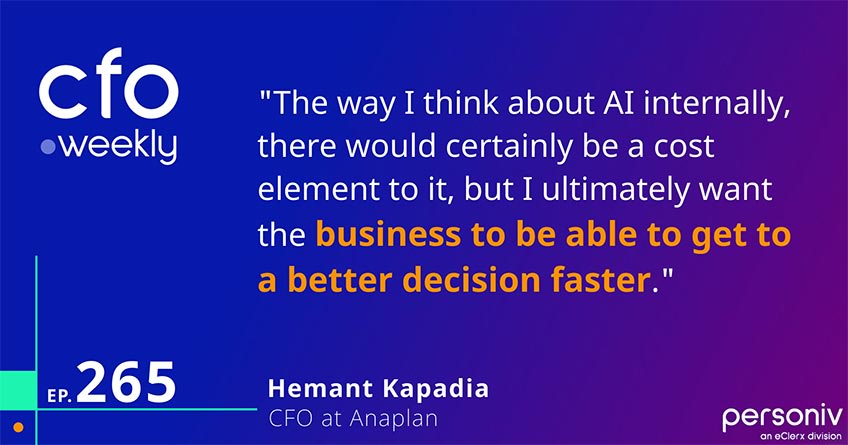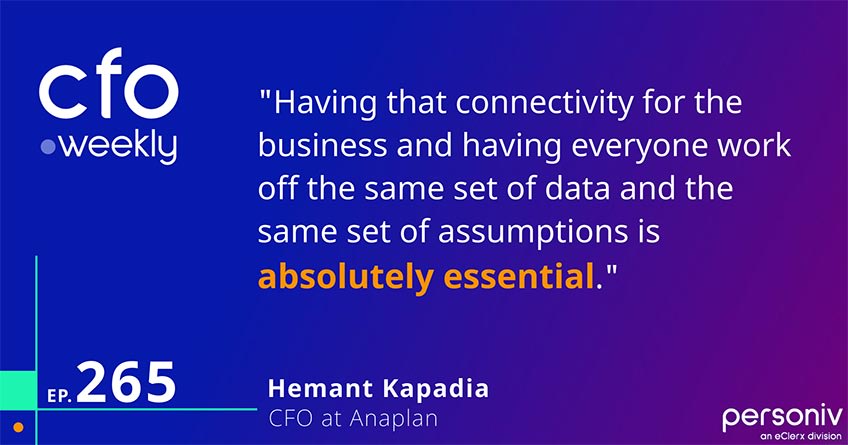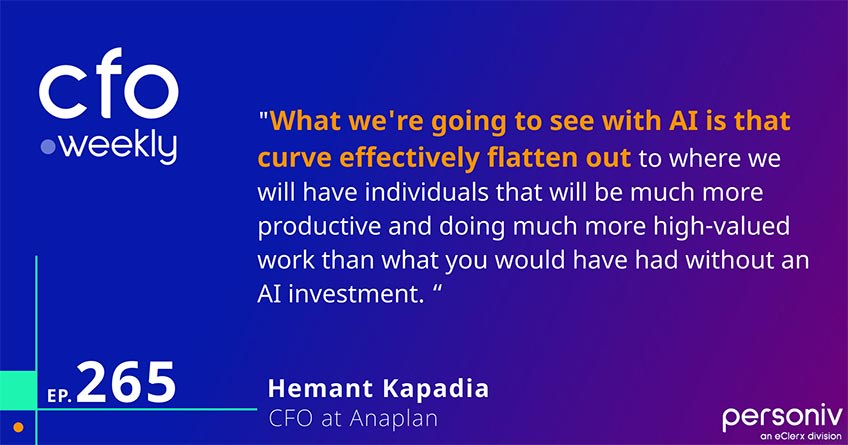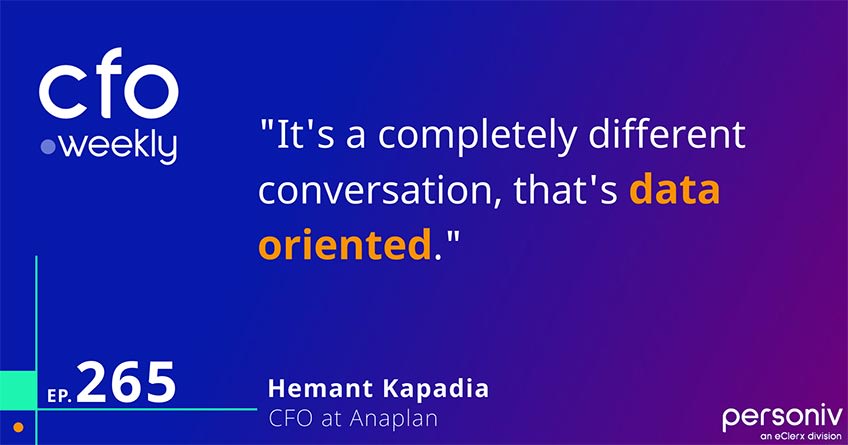
In this episode of CFO Weekly, Hemant Kapadia, CFO at Anaplan, joins Megan Weis to explore how modern CFOs are transforming financial planning and strategic decision-making through AI-powered scenario modeling and connected enterprise planning. Hemant brings a unique blend of engineering precision and financial acumen, having started his career as an electrical engineer at GE before transitioning into finance leadership roles.
With over 30 years of experience across public and private companies, including CFO positions at Sirius Computer Solutions, Markandy Inc., and MEMC SunEdison Semiconductor, Hemant shares how finance teams can leverage AI to accelerate decision-making, eliminate organizational buffers, and build resilient planning systems. Currently serving as CFO of Anaplan, an enterprise decision-making platform, Hemant oversees traditional finance functions while helping CFO customers deliver outsized business outcomes through connected planning across finance, supply chain, sales, and workforce domains.
Show/Hide Transcript
Megan - 0:16: Today, my guest is Hemant Kapadia, a visionary finance leader who has been at the forefront of using technology to reshape how organizations plan, forecast, and make decisions. From his early days as a CFO to his current role helping enterprises unlock the full potential of data and AI, Hemant has seen firsthand how finance is evolving from a backward-looking function to one that anticipates and shapes the future.
Hemant is Anaplan's Chief Financial Officer and leads Anaplan's various traditional finance functions as well as procurement and real estate. In addition to delivering against Anaplan's own growth goals, Hemant leverages his firsthand Anaplan expertise to help the company's CFO customers deliver outsized outcomes within their respective businesses. Hemant previously served as CFO at Sirius Computer Solutions for nearly three years. There, he helped drive the business to more than triple equity value by driving revenue growth, M&A, margin expansion, and relentlessly focusing on cash flow. With over thirty years of experience with both public and private companies, Hemant has held CFO positions at Markandy Inc. and MEMC SunEdison Semiconductor. He currently serves as the Executive Sponsor of Asia Plan, an employee resource group at Anaplan representing employees from the Asian community. Hemant holds an MBA from Rensselaer Polytechnic Institute and a bachelor's degree from the University of Tennessee. Hemant, thank you for joining me today.
Hemant - 2:17: Thank you, Megan, for having me.
Megan - 2:18: So to kick us off, what was the first moment you realized that traditional financial modeling wasn't enough and that AI could fundamentally change how businesses plan for the future?
Hemant - 2:30: Look, I think COVID was an interesting time frame that really brought to the forefront. There was a lot of uncertainty in your top line: Will your employees come to the office? Will you be able to get goods from various locations? Shortages, and otherwise. And just being able to dynamically adapt and understand the impact to your businesses was really important.
I was in the tech space at the time, and so that has obviously transitioned to our current environment, which is just as equally dynamic today with tariffs, trade wars, foreign exchange, what's happened with AI. All of those things are factors that are leading to a lot of uncertainty in the business environment. So that's definitely one thing that we're seeing.
If I take a step back, I have the advantage of being at a company that actually, as you mentioned, is one of the leaders in planning, not only in the Office of the CFO, where I am obviously interested in, but more broadly across the enterprise, whether it be supply chain, sales, or in workforce, and being able to connect all of that together to understand how a business can plan enterprise-wide.
Megan - 3:45: And your perspective as a former CFO gives you a unique vantage point. So how did those early experiences shape the way you think about scenario planning and its importance in strategic decision making?
Hemant - 3:58: I'll take a little rewind of the clock a little bit more. I think it gives a little perspective on my mindset. So I actually was an electrical engineer for the first ten years of my career, and so, obviously, a lot of math is involved there, a lot of process, a lot of critical thinking from that standpoint.
Then, as I transitioned into the finance realm—I was at GE at the time—I was at some of the lower-margin businesses, which ultimately allows you to refine your skill set as it relates to making sure you deliver on the investments that are being made because there's not a lot of margin in the business to ultimately support investments that don't necessarily work. And you're squeezing every penny out of the ecosystem, if you will.
My engineering background, being more process-oriented, having grown up in low-margin businesses, has given me that viewpoint of I want to ensure that every investment that the business makes has a grounded path to delivering an outsized outcome, and actually, we can measure what that outcome is. And so, again, getting back to that connectivity across the business, being able to measure, having the metrics be consistent is super, super important.
Megan - 5:20: And as AI continues to advance, it's transforming how finance teams approach forecasting and risk management. What are some of the most powerful shifts that you've seen in practice?
Hemant - 5:32: Obviously, you can't open up an article today without reading about AI. I would say that our solution sets, and even in some of the solution sets we're employing, are leveraging a lot of LLMs, whether it be on time series forecasting capabilities or some of the predictive aspects of understanding our customers' usage behaviors and the like. That would be more on the front end of the business.
But I think on the back end, the business is equally impacted from a standpoint of there's an efficiency aspect not only on engineering, coding, especially with some of these more sophisticated LLMs and solutions that are out there, should be driving twenty, thirty, 40% improvement in not only the ability to develop new software solutions, but the QA aspect of it doesn't have the human bias towards the author of the code, so it's very pragmatic. And then being able to release software also should be much more efficient. So I think there's a whole dynamic within the development cycle.
On the back end, from a G&A perspective, I think there could be opportunity from a cost efficiency standpoint. But the way I think about AI internally, there would certainly be a cost element to it, but I ultimately want the business to be able to get to a better decision faster and leverage the capabilities that we have on our platform and Anaplan, but also to dovetail that into whatever solutions can I plug in that allows me to make those decisions and those connections a lot faster? Because it's that network effect across a business that really unlocks a lot of capability and a lot of value for the ultimate shareholder.
Megan - 7:32: And just really quickly, tell us a little bit about Anaplan.
Hemant - 7:36: So Anaplan is an enterprise decision-making platform. I say decision making as opposed to planning platform because planning really doesn't capture the full essence of what we do. We have a unified platform which not only serves the Office of the CFO through financial planning, consolidations, but also from a sales forecasting territory and quota, incentive compensation, supply chain from supply planning, demand planning, consumer planning, etc., to also workforce. So your staffing, being able to dynamically model it, ups and downs, and then seeing what the financial impact of that is.
You can imagine when you connect all of those domains together, you have a solution that can very dynamically estimate and plan your business in real time. I come back to decision making because when you're able to see the impact of the frontline of your business—something changing in your pipeline or in your sales forecast—understand what the ripple effect is on profitability and cash flow, you can make decisions on if you're going to lean into new investments, if you've got capacity, or pull back on others if you've got a shortfall coming in your particular quarter or a year. So that allows you to run your business with a much lower safety factor and still feel comfortable with hitting your outcomes. So to boil it back down, we're a decision-making platform that is enterprise scale and enterprise resilient.
Megan - 9:26: And does it just sit on top of an ERP?
Hemant - 9:29: That's a great question, Megan. We interface with all the major ERP systems out there, whether it be Oracle, SAP, or Workday. And the way we think about ERPs is that they are transactional systems. They will execute on a particular function or action. However, the true value in a business is being able to understand what actions you should be taking to optimize the business outcome. So leveraging that data that's in the ERP or in a CRM or in an HCM for workforce, and being able to bring all that data together on a unified platform is really where we've seen a lot of value for our customers.
Megan - 10:16: And great insights are only as valuable as their execution. So how do you ensure that the outputs of scenario planning are not just modeled in spreadsheets, but that they're actually communicated, understood, and acted upon across business functions?
Hemant - 10:31: I think what we try to do is democratize data across a business, obviously, with guidelines for who has access to what data, sensitive or otherwise. And I think this really comes down to having alignment across functions. If sales is making a decision on a promotion, it should be tied to what a supply chain buyer is actually communicating with the supply base. And then, obviously, the finance team would need to understand what the implications are on working capital or the top-line forecast or bottom-line forecast for that matter.
So having that connectivity for the business and having everyone work off the same set of data and the same set of assumptions is absolutely essential. Because if you think about the impact of creating buffers through an organization, if you've got a salesperson that will say, "Well, I'm going to add a 20% buffer on my forecast because I want to make sure supply chain buys enough." Then supply chain says, "Well, I'm going to put a buffer because I don't want to stock out." So they go back to the supplier and the supplier says, "Well, I need to put in a buffer because I don't want to have a shortfall." If you think about all of the inefficiencies that's accumulated through the system, when you're running off the same set of data and you have confidence in that data through an enterprise, you can actually run much more efficiently.
A case in point, it's an interesting example of a customer. We have a very, very large semiconductor design house that farms out their production to various fabs across the world, and they deal with the fabs making the chips, the packaging companies that put them into sub-assemblies, the board manufacturers, the chassis manufacturers, and ultimately, the installation at data centers and the like. When you imagine the complexity of that entire supply chain and to do that in an efficient manner, it is no small task. Our customer has been able to grow their revenue multiple times over a very short period without adding materially to their operating team. That's a testament to having everyone looking at the same set of data in a consistent manner, so there isn't redundancy in the network within the organization. I think that in and of itself is an example of a case where that connectivity is super powerful, and it's led to outsized returns for their shareholders, of which I am actually one, and you might actually be one too.
Megan - 13:20: That's amazing. So implementation is where many organizations stumble. From your experience, what are the most common pitfalls that companies face when introducing AI-driven financial modeling, and how can they avoid them?
Hemant - 13:33: I think it starts with having a clear understanding of outcomes. So what are you trying to achieve, and then having a team that's actually aligned with delivering those outcomes. I know that sounds pretty basic, but many times, the implementations of new solutions become a second or third job done after hours. That can work, but the probability of it working is much lower than if you have a focused team. If the project is important enough to the business—where AI or any implementation of a major system should be driving an outsized business outcome—you should have some element of a dedicated set of resources.
I think the other part is making sure that all the parties involved—because generally there's a third party, call it system integrator or some professional service organization—are also at the table hearing all these messages at the same time. Then that leads to a regular cadence of open communication to make sure that everyone is following up on the task. Call it typical project management, but you'll be surprised how often it doesn't happen, and one group feels the other person should be doing it and vice versa. That is super, super important.
We have a program called Value Assurance that we run with all of our new customers to ensure that there is that alignment through the organization, not only from a resourcing standpoint, but also the outcomes that the business is looking to achieve. Because identifying that early on is so important to make sure you don't get to 75% complete and then have to restart the project. That does not serve the champion for the project or either of our companies in any way. So getting that alignment is super, super important.
Megan - 15:41: And looking further ahead, AI-driven planning is starting to influence investment and capital allocation decisions. How do you see that continuing to evolve over the next few years?
Hemant - 15:52: It is quite remarkable the amount of money that is being allocated to AI. I think there's an element of FOMO, a fear of missing out, especially the large hyperscalers, which we'll see how that pans out. It feels a little like the dot-com era right now.
But I would say the investments that we're looking at internally are focused on what I mentioned earlier, which is driving efficiency, but I think it's driving the efficiency of decision making, which is more important for me. If I can use AI to bring the organization together to where we're making a decision faster about a particular customer proposal or a particular internal development project, fantastic. That allows me to increase the pace of innovation and pace of responsiveness with our customers.
A lot of the development that we're doing internally is really focused on making our customers more efficient from an implementation of AI itself. One solution that we're in the process of rolling out is a product we call CoModeler. For those that have used Anaplan in the past, you basically build bespoke models or use our applications, which are out-of-the-box functional for any of the domains that are out there. But what CoModeler does is, with natural language prompting, you can actually have the solution actually build a model for you to do a particular analysis or serve a particular use case across the business.
Why is that important? Historically, it would have taken three, four weeks in order to bring a particular model up to operating conditions. What you can do now with CoModeler is have the guts of the model built in a matter of hours, and then you have a model builder basically do the last tweaks, something with the UX, and you're up and running in a day or two as opposed to in weeks. That is a huge game changer, and it gets back to the whole vision about AI is just going to continue to increase the pace of development of solutions, development of new practices inside businesses, and those that jump on board with that are just going to outpace the competition.
So we're really, really excited about not only the solutions that we're bringing to market from an AI perspective, but the other solutions that we're implementing internally. We've got an entire team focused on internal AI adoption. We've got AI rolled out across more than half of the company from an LLM and an AI portal, if you will, and we're adding different agents to that on a daily basis. So I'm super excited about what the outcome of that's going to be, not only for the go-to-market team, but in pre-sales, from our customer success teams, R&D teams, and then back office.
Ultimately, I think what we'll see is our normal trajectory has been to grow our headcount materially each year, in the 10 to 15% range. I think what we're going to see with AI is that curve effectively flatten out to where we will have individuals that will be much more productive and doing much more high-valued work than what you would have had without an AI investment. So I truly see this as a game changer, as virtually the entire market does too. I'm not alone in that.
Megan - 19:40: And when can your customers expect to see that CoModeler update?
Hemant - 19:45: We have certain customers going on beta this month, and it will be available early next year for general availability. It is super, super exciting.
It is just one part of our overall AI portfolio. We have Anaplan Forecaster, which is our time-based forecasting engine, which we've just rolled out a new version. We've had forecaster capability for a number of years now. We've got analysts for each of the domains being pulled out in the next thirty to sixty days, and we're staggering each one. So we've got a Finance Analyst, a Supply Chain Analyst, and a Workforce and Sales Analyst.
You could think about those as being analysts that you would be able to query in the same way that you would ask, let's say, a finance analyst to do a particular analysis on, call it, travel expense or OPEX hiring versus COGS hiring, etc. You could do a lot of that. But where it really becomes powerful is when you can ask questions which cut across all of those domains, where you can ask a question that asks about if I were to change a particular sales forecast, what would the impact be to the supply chains and certain suppliers and the impact to factories and the associated workforce and the impact to a P&L? Being able to do that in a very dynamic way allows you to really make decisions that you couldn't make before.
In fact, one of our customers is a large automotive customer out of the UK—you can imagine who it is—actually prices their vehicle options like airlines price airline tickets. What I mean by that is, if you imagine the factory produces a vehicle, they'll actually ship the vehicle without a sticker with pricing. So depending on where that car is going in the world, they will send a sticker to the dealership based on the current foreign exchange rates, supply demand in region, commodity pricing, margin expectations, any transfer pricing requirements. They'll be able to do that every seventy-two hours, whereas they were historically only able to do this twice a quarter. So it's just a different level of decision making, which they just didn't have the ability to do before. That is really, really exciting. It gets back to the conversation about having a connected enterprise planning solution.
Megan - 22:25: And can you share a real-world example where scenario planning helped your team navigate a sudden disruption, whether it was in the market, operations, or supply chain?
Hemant - 22:35: I would say, we've internally just developed a customer profitability solution, which leverages some of our forecaster capabilities we talked about earlier. But it pulls in cloud hosting data, it pulls in our customer data from sales, and it pulls in our workforce that's allocated to a particular customer.
With all of those data sources, again, it's that connected nature of multi-domain datasets coming together in one platform where I can look at my profitability of customers in a very dynamic way in near real time. With that, when customers are up for renewal, I can have a different conversation about where should this customer be priced, whatever solutions can we introduce in order to change the trajectory of the posting costs or the support costs or what have you. So it's a completely different conversation that's data-oriented. And you think about there were a couple customers that just after I started looking at the data, I sent off a couple of emails, and behold, the renewals are a lot more favorable to us than they would have been otherwise. That is the power of having that connectivity and being able to make those decisions in real time.
Megan - 24:03: And you've touched on this a bit, but at Anaplan, you've had a front-row seat to how companies are embedding AI directly into their planning platforms. So how does Anaplan help clients operationalize AI-driven insights into their day-to-day decision making so that they get the most out of it?
Hemant - 24:20: I think the CoModeler is going to be a game changer because our customers have internal teams that are rolling out Anaplan and different use cases across the business, or they're leveraging partners or GSIs, if you will. One of the truly empowering elements of CoModeler is it's going to greatly increase the velocity at which they can deploy these new use cases, and it will drive them to having that connectivity across the business or even sub-functions within a particular domain—domain being the Office of CFO or supply chain or sales, etc. That is going to be a huge unlock.
But from a cost perspective, because they may not need to leverage professional services in the future, and I think this is really the more impactful part: Having that connectivity and these incremental use cases in place, they will actually be able to make better decisions. And the margin impact or the business impact associated with those decisions is going to greatly outweigh any of the cost benefit that you would get from a pure efficiency standpoint from a headcount perspective. So I think that's really where I see the benefit coming.
Megan - 25:43: And finally, when you look to the horizon, what do you see as the next frontiers for AI in finance, particularly around scenario planning, resilience, and adaptive strategy?
Hemant - 25:54: I think it's more of the same. I think it's going to be a faster pace of change in the marketplace, and the companies that are best positioned to adapt to that pace of change in the market are going to be the ones that thrive.
If I just think about all of the things that have changed in the last year: there have been different geopolitical issues, there have been trade wars, there have been currency changes, there have been the investment needs in AI. All of these factors are all coming into play at the same time, and there are different laws that are being introduced in different regions around the world. We live in a global economy. From that standpoint, understanding what the impact to businesses is and being able to adapt to it quickly is going to be essential. So if you're not prepared for that, I wish you luck because it's not going to be pretty.
Megan - 26:56: Hemant, this has been such a rich discussion about how AI is not just augmenting finance, but truly redefining its purpose. Thank you so much for your time today.
Hemant - 27:06: Thank you, Megan.
Megan - 27:07: I truly appreciate the insights you provided us today. And to all of our listeners, please tune in next week. And until then, take care.
What You'll Learn:
-
Why traditional financial modeling is insufficient for today's dynamic business environment
-
How AI-powered scenario planning enables real-time adaptive decision-making across enterprises
-
The critical importance of connected planning across finance, supply chain, sales, and workforce
-
Strategies for eliminating organizational buffers through unified data and transparent planning
-
How AI accelerates model development from weeks to hours with solutions like CoModeler
-
The future of dynamic pricing, customer profitability analysis, and enterprise-wide AI adoption
Key Takeaways:
AI Transforms Both Front-End and Back-End Finance Operations
AI is revolutionizing finance through time series forecasting, predictive analytics for customer behavior, and dramatic efficiency gains in software development. The focus should be on enabling faster, better decisions through connectivity across business functions rather than just cost reduction.

"The way I think about AI internally, there would certainly be a cost element to it, but I ultimately want the business to be able to get to a better decision faster." Kapadia explained. - 00:05:20 - 00:07:32
AI-Powered Enterprise Scenario Planning Eliminates Organizational Buffers
When organizations run off the same unified data across functions, they eliminate the compounding inefficiencies of buffers created by sales, supply chain, and suppliers each adding their own safety factors. This connectivity enables dramatic growth without proportional headcount increases.

In Kapadia's words, "Having that connectivity for the business and having everyone work off the same set of data and the same set of assumptions is absolutely essential." - 00:09:26 - 00:13:20
How CFOs Benefit From AI-Powered Scenario Planning
AI-powered natural language model building through CoModeler enables finance teams to create complex analytical models in hours instead of weeks. This acceleration in development speed allows organizations to increase their pace of innovation and responsiveness dramatically.

"What we're going to see with AI is that curve effectively flatten out to where we will have individuals that will be much more productive and doing much more high-valued work than what you would have had without an AI investment. So I truly see this as a game changer, as virtually the entire market does too.“ Kapadia noted. - 00:15:41 - 00:19:40
Real-Time Customer Profitability Analysis Drives Strategic Pricing
Connected planning enables dynamic customer profitability analysis by integrating cloud hosting costs, customer usage data, and allocated workforce in real-time. This visibility transforms renewal conversations and pricing strategies with data-driven insights.

"It's a completely different conversation, that's data-oriented." Kapadia pointed out. - 00:22:25 - 00:24:03
For more interviews from the CFO Weekly podcast, check us out on Apple Podcasts, Spotify, and our RSS or your favorite podcast player!
Instructions on how to follow, rate, and review CFO-Weekly are here.
Ready to build a more resilient and adaptive finance function? We deliver premier finance and accounting solutions tailored to help CFOs leverage AI-powered tech for strategic growth. Drop us a line today to learn more.





















